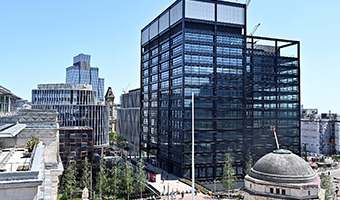The region scored a major coup earlier this year when both McLaren and Boeing committed to bring manufacturing facilities to the Advanced Manufacturing Innovation District (AMID) on the Sheffield-Rotherham border.
In February, McLaren Automotive signed a deal to construct an R&D and production facility at the AMID. The car manufacturer is setting up a composites technology centre - its first purpose-built facility away from its campus in Woking, Surrey - in a £50m deal structured through a partnership between McLaren, the University of Sheffield and Sheffield City Council.
According to McLaren chief executive Mike Flewitt, the firm needed a facility at which it could produce carbon-fibre chassis.
“We evaluated several options to achieve this objective but the opportunity created by the Advanced Manufacturing Research Centre (AMRC) at the University of Sheffield was compelling,” he says.
Only weeks later the AMID consortium struck gold again, this time signing aeronautics giant Boeing to a facility where it will produce high-tech components for the next generation of three of its aircraft models.
Long-term prosperity
Boeing chose the AMID because it has a long-standing relationship with the University of Sheffield, dating from 2001 when the two came together to create the AMRC - the world-class machining and materials research campus that will be home to McLaren. The proposed 25,000 sq ft Boeing Sheffield facility will be built alongside the AMRC.
“Our decision to start manufacturing high-value components in the UK is a step-change in our engagement and a further example of Boeing’s commitment to grow here, supporting the UK’s long-term prosperity,” says Boeing Europe president Sir Michael Arthur.
|
SHEFFIELD’S ADVANCED MANUFACTURING INNOVATION DISTRICT
|
Councillor Leigh Bramall, deputy leader of Sheffield City Council and cabinet member for business and economy, believes attracting McLaren and Boeing is “further proof that the AMID is the place for leading manufacturers to come not only for research and development and industrial collaboration, but also for production”, and that further such deals will follow.
His confidence is understandable. The AMID is a vast, production-led district that was successful in attracting high-calibre occupiers even before the coup of McLaren’s and Boeing’s deals. Broadly, the AMID encompasses three sites totalling more than 2,000 acres to the east of Sheffield city centre. Two straddle the Sheffield Parkway, which links the city centre and the M1, while the third extends through the historic heavy industrial sites of the Don Valley, taking in the site of the old Don Valley athletics stadium.
The most developed is Harworth Estates’ Advanced Manufacturing Park (AMP), south of the Parkway. The 100-acre site already houses Rolls-Royce and Castings Technology International and will be the new home of McLaren Automotive.
It forms part of the wider Waverley scheme, Yorkshire’s largest-ever mixed-use development. This 740-acre former industrial site, which once housed the Orgreave colliery and coking works, is being transformed by Harworth into a community boasting 4,000 homes as well as shops, restaurants, schools, leisure and public facilities and parks, in addition to the AMP.
To the north of this is the site of Peel Holdings’ short-lived Sheffield Airport, which operated from 1997 to 2008 and has been relaunched as the Sheffield Business Park. This is now home to the University of Sheffield’s AMRC, where Boeing and McLaren will operate.
Spectacular complex
The centrepiece of phase one is Factory 2050, which was formally opened earlier this month. The spectacular circular complex is described as “the UK’s first fully reconfigurable collaborative research facility, dedicated to digital assembly and flexible component manufacturing”. Teams at Factory 2050 are already working with manufacturing partners on projects spanning robotics and automation, digitally assisted assembly and manufacturing informatics.
For phase two of the Sheffield Business Park, which will be built on the site of the disused runway, Peel has consent for 900,000 sq ft of mixed-use space with enterprise zone status.
The third element of the AMID is in the Don Valley, where Sheffield Hallam University, Sheffield Teaching Hospitals NHS Foundation Trust and Sheffield City Council will work together to develop the Olympic Legacy Park on the site of the former Don Valley Stadium.
“Our team has led the charge to create a place that draws in and develops world-class people and a place where the world’s leading companies come to explore new technologies and operating methods and to deliver research and technology into the UK’s supply and value chains,” says Bramall.
So what does all this mean for the Sheffield market? Adrian Lunn, director at Lambert Smith Hampton in Sheffield, believes that this year’s spate of high-profile deals has changed perceptions of Sheffield.
“We’re seeing companies actively looking to place R&D and high-tech uses in the area,” he says. “They’re saying ‘we’ve got to be as close as possible to this’.”
One of the reasons the approach has been so successful is that it builds on Sheffield’s traditional strength in materials science and precision engineering. “We’re never going to compete with Leeds in financial services or with Manchester in media, but what we’re good at is manufacturing,” Lunn says. “We’re building on the existing skills base, and the universities have been key to that.”
Lunn adds that the AMID is already having a measurable impact on the market. New space at the AMP is quoting a rent of £7.50/sq ft - £2/sq ft higher than sites elsewhere. That £2/sq ft difference is a significant one. At that higher level, development of more new space is financially viable without the need for subsidies. And that means further phases of development could be self-sustaining.
“At that level, it stands on its own two feet - it could finance new development,” Lunn says. “When a city’s time has come, it’s a wonderful thing.”
Sheffield’s time came and went. Now, it appears to be enjoying its second coming.
This article was first published in Property Week on 20 April 2017 - click here to view the original article.
REGISTER FOR UPDATES
Get the latest insight, event invites and commercial properties by email







